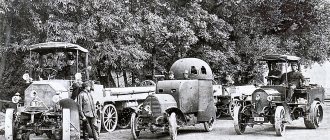Story
We already talked a little about the history of the appearance of this bus when we shared our impressions of a trip on the all-wheel drive version of the PAZ-3201S. We will not repeat ourselves, but we will briefly recall the most important moments of the birth of 672.
This bus can be considered a record holder for the time it takes to design and get onto the assembly line. More precisely, “anti-record holders”, because only “in paper” it existed from 1957 until the end of 1959, and from the release of the first samples to the series it managed to last another five years - until 1964. And when they finally decided to produce it, something went wrong again, and as a result, the first PAZ-672 was welded only in October 1967, exactly 10 years after the start of design. The question arises: why did this happen?
PAZ-672 '1964–67
Of course, some things on the bus had to be changed, looking at the shortcomings of the pre-production samples. For example, the braking system received separate drive on the front and rear axles. In addition, the body has been noticeably changed, increasing the glass area and reducing its weight. All this, of course, greatly delayed the process, but the main culprit for the protracted labor was the GAZ-53. The fact is that just at this time GAZ tested and put into production this truck, which replaced the old GAZ-52 and GAZ-51A. On the basis of the latter, the predecessor of the PAZ-672, PAZ-652, was built, but on the basis of the new GAZ-53, the new PAZ-672 was built. It seemed quite logical, but it turned out to be a little difficult: the technical differences between the GAZ-51A (and GAZ-52) and the new GAZ-53 are significant, although they are very similar in appearance. The GAZ-52 is a development of the GAZ-51 with a straight-six engine under the hood, and the GAZ-53 had a new V8 engine at that time. And before putting this engine in a bus, it was necessary to find out how it would behave in a truck. But there are also axles, a gearbox... PAZ got all this from the same GAZ-53. So you shouldn’t blame the specialists from Pavlov who tinkered with this bus for so long: it’s ugly to go ahead of your dad into hell, and even less so to build a bus ahead of a truck.
GAZ-53 '1962–65
The suffering of the martyr bus did not end there. They continued to diligently “finish” it, periodically changing something in it. As old Hegel said, any new quality is only the result of accumulated quantitative changes. To confirm the truth of his words, he cited water, which becomes steam when temperature accumulates, but if he had been born a little later, he could have taken PAZ-672 as an example. But Hegel, unfortunately, died long ago. And the PAZ-672 accumulated so many changes that over time it became the PAZ-672M.
PAZ-672M '1982–1989
It is clear that the main goal of the adjustments made to the design was to increase the service life of the bus, which eventually became equal to as much as 330 thousand kilometers (which allowed some of its modifications to receive the honorary quality mark “made in USSR”), however, an exhaustive list of these changes would take up the entire disk space on our hosting. For example, to reduce noise in the engine compartment, they installed an enlarged pulley for the power steering pump, made an indication of an emergency drop in oil pressure in the engine, connected an air duct from the “stove” to the driver’s door, changed the profile of the springs, built a relay regulator into the generator, increased the volume of the master brake cylinder... This is a very incomplete list; in fact, there were more alterations.
Professionals distinguish 672 from 672M by the shape of the leatherette thermal and noise insulation of the front panel of the heating duct, the tops of the handrails of the passenger seats with a safety tubular coating and the decorative pattern of the trim panels in the cabin. And we, mere mortal passengers, can focus on lighting technology: the front and rear dimensions and direction indicators have become rectangular rather than round in accordance with UNECE rules. True, this happened back in 1978, and the model received the letter M in ’82. But what is four years for this bus? One day!
So was it worth it to suffer for so long? From the perspective of the modern world, this model was hopelessly outdated even before it was put into production. But then the time was different, and the people, and the buses. And most importantly - the roads along which this PAZ was supposed to move relatively without problems. And since they planned to drive him head and shoulders across districts, state farms and villages throughout the USSR, the requirements for him were appropriate.
Paz's second birthday
A deep refurbishment of the plant began in 1950. It was renamed, and the initiative began to be called the Pavlovsk Bus Plant. The re-equipment of industrial premises and the new plant were completed by 1952. Asteroid 5 is an official date that marks the release of the first batch of products. Five smoky-looking buses left the assembly line. The PAZ-651 bibliobus was created on the basis of the Nizhny Novgorod GAZ-51 car. The factory workers were supposed to release approximately 10,000 units of vehicles. After the start of production of equipment at the Kurgan Bus Plant in 1958, documentation and the necessary equipment were handed over there. It was necessary to increase the production of buses, in which the economy and the citizens themselves were poor.
And just before that, Paz’s designers came up with a new type of bus. 652 modification was carried out deliberately with a freshly baked sample. The PAZ 652 was a smoke-free design, and one of its modifications was all-wheel drive, which later became a necessary and useful ingredient in transport. The successful 652 modification was tested in new incarnations just before release.
Interesting: History of TESLA.
672 version was made in its warehouse, some were in demand on the market and were produced until 1989. Production of Paz 672 began in 1968.
The plant's guidance was able to improve the production of a freshly baked sample without stopping the general line. The plant's designers continually changed base models, and the aircraft model range increased. For the first time in the late 70s, they presented their products at international exhibitions.
Specifications
- Length: 7150 mm
- Width: 2440 mm
- Height: 2952 mm
- Wheelbase: 3600 mm
- Minimum ground clearance: 280 mm
- Curb weight of the bus: 4535 kg
- Gross weight: 7825 kg
- Seats: 23
- Total passenger capacity: 45 people (in practice, up to 100 people were transported)
- Maximum speed: 80 km/h
- Fuel consumption: 20.5 l/100 km
- Engine: ZMZ-672, carburetor, V-shaped, four-stroke, eight-cylinder, overhead valve, displacement 4.25 l, maximum power - 115 l. With.
- Clutch: single disc, dry, hydraulically driven
- Transmission: manual, four-speed
- Main gear: single, hypoid
- Steering mechanism: globoidal worm and three-ridge roller
- Tire size: 8.25-20
History of creation
The mass production of the PAZ-672 modification was preceded by a long period of improvements. Designers began working on the development of the model back in 1957. As a result, the vehicle was equipped with a hydraulic power steering mechanism and a V-shaped engine. After the release of the first production model in 1959, work continued to “correct the mistakes.”
After this, the PAZ-672 appeared, which primarily became a copy of the 652-B modification. Among the differences from its progenitor are a new body frame, larger windows and a reduced weight of the structure. The real starting version was born in 1967.
Modifications
Over the past 22 years, the manufacturer has released a huge number of configurations of the popular model.
PAZ 672 M
This bus deserves special attention. Its release took place in 1982. The postscript “M” is nothing more than an abbreviation for the word “modernized”.
The classic PAZ 672 bus was noticeably inferior to its successor in terms of technical characteristics. The new product was equipped with a more powerful engine. Inside the cabin there is insulation from external noise, as well as thermal insulation. The seats have become safer and more comfortable, making the 672 M a particularly favorite model among passengers.
After some time, single-door configurations began to be called the “M” model. Due to the presence of only 1 door, 2 more seats were installed inside the cabin. But in 1989, their production was discontinued.
The device turned out to be so reliable that even now it can be seen on the go. The 672 M gained particular popularity among enterprises and factories, where it was used as a service vehicle.
Representative 672 A
Next, the designers released modification 672 A, one of the best buses for excursions of the Soviet era. The door was opened manually and the roof was retracted. But even such distinctive features did not increase the profitability of production. The model was quickly removed from the production lines.
Exhibit with index 672 Yu
These are chassis produced for export purposes. The configuration found particular popularity in Cuba, where a huge amount of interesting equipment was produced with its help.
Bus 672 G
The mountain model has been specially adapted for harsh operating conditions. 2 fuel tanks appeared on board. Each passenger seat received a separate seat belt. The braking system has become much more reliable.
This variation served to create another one, called “Penguin”. The funny name is due to the presence of a refrigerator-air conditioner inside, just like in a refrigerator. Subsequently, the stamp received the number 3742, as well as a snowflake design on the side.
Characteristics 672 TL
The designers created this particular model for moving laboratories. It was distinguished by a solid roof and internal division into compartments.
Latest bus models
Continuing the topic of research, we must not forget 652 C (from the word “North”). The interior had an independent heating system, a roof without glass and double glazing on the windows. All opening parts were insulated with rubber inserts.
Finally, let us remember the single model 672 D with a Minsk diesel engine. This bus did not go into production, despite its enormous potential. The track record of the device is great; it left a huge mark in the history of the Soviet automobile industry. Reliability and simplicity of design, optimal design, as well as variability in modifications made the “Pazik” a real legend.
Main models
Over the 22 years of serial production of PAZ-672 vehicles, the Pavlovsk Automobile Plant has changed the technical characteristics taking into account the demand and preferences in the relevant market.
The most popular modifications:
- Series 672-A. This example is equipped with a lightweight sliding roof. It has one door in the front with manual opening without glazing. The first version was assembled back in 1967, mass production was canceled due to unprofitability.
- Model 672-VYu. The vehicle is a version on a self-propelled chassis, which was imported to Liberty Island (Cuba) from 1971 to 1989. A special feature is multi-purpose body designs. The number of units produced is from 2500 pieces per year.
- The PAZ-672 G was oriented towards mountainous terrain and was equipped with two 105 liter fuel tanks. The equipment includes belt equipment for all seats, hydraulic power steering, and seat belts on all seats. On the exterior of the car, the glazed roof slope has been changed, and improved brakes have also appeared. In addition, there is an angular stop for stopping on inclines of up to 25 degrees, and the ability to open the trunk from the inside.











